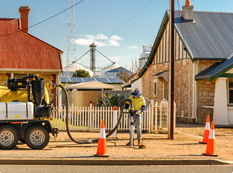Proactive environmental leadership
Proactive environmental leadership
As a leader in environmental management, and by partnering with our stakeholders, customers and community, we are taking action to adapt to climate change, and finding ways to reduce our greenhouse gas emissions.
We make decisions that reduce waste and grow opportunities to reuse resources and by-products of our production processes to create environmental benefits.
Continued pursuit of a Zero Cost Energy Future
Renewable energy continues to make a positive environmental impact and supports us in delivering ongoing operational savings. Throughout 2021-22, we continued to pursue a Zero Cost Energy Future with the energisation of a further 11 sites with 194,397 panels, producing an estimated 124,451 megawatt hours of energy per year and creating 13,568 kilowatt hours of on-site battery storage, including:
- 3,996 solar panels at Aldinga Wastewater Treatment Plant in January 2022. Together with more than 1,000 kilowatt hours of on-site battery storage, the fixed tilt solar array has a generation capacity of 2,439 megawatt hours of clean, green solar energy per year.
- More than 2,000 solar panels at the Myponga Depot generating 1,238 megawatt hours of energy each year. The large-scale solar array combines with around 352 kilowatt hours of on-site battery storage.
- Around 2,900 solar photovoltaic panels at Balhannah’s 490 million-litre capacity Summit water storage and treatment plant, combined with 528 kilowatt hours of on-site battery energy storage.
Our Zero Cost Energy Future program continued to collect accolades in 2021-22. At the National Australian Water Association Awards in May 2022, the program won the Infrastructure Project Innovation (metro) Award and in June 2022, at the iTnews Benchmark Awards in Sydney, our Zero Cost Energy Future energy management system was named Best State Government Project.
.
Conservation and restoration of reservoir reserves
In 2021-22, we continued to restore the watercourse within Myponga Reservoir Reserve, along with Victoria Creek in the South Para River catchment.
Revegetation projects using local provenance native woodland species were completed at Myponga and Hope Valley, and we successfully re-introduced native grasses at Warren, Myponga, South Para and Hope Valley Reservoir Reserves.
Weed control programs were active across all reservoir reserves in 2021-22, targeting declared and environmental weed species, such as Erica baccans at Mount Bold Reservoir Reserve. We continue to partner with other government agencies to expand priority feral animal control programs across land tenure, with more than 1,300 feral animals removed from the reservoir reserves in 2021-22.
A new 10-hectare conservation area within Myponga Reservoir Reserve was announced in June 2022 to improve the habitat and provide sanctuary for some of the most threatened wetland birds on the Fleurieu Peninsula, including the Australasian Bittern and Southern Emu-wren. More than 14,000 seedlings had been planted at 30 June 2022, with customised marker buoys deployed to establish the area at the eastern end of the reservoir, and fencing installed to protect the young plants from kangaroos.
Circular solutions for Port Lincoln Wastewater Treatment Plant
In partnership with Aurecon, we designed and delivered a bespoke circular solution for the Port Lincoln Wastewater Treatment Plant which was awarded an Infrastructure Project Innovation Award Regional at the Australian Water Association South Australia Awards in November 2021. By replacing the sludge lagoons with a mechanical thickening, anaerobic digestion and mechanical dewatering process, the new treatment infrastructure has reduced methane emissions and improved odour management, while achieving a suitable biosolids by-product for beneficial reuse by local farmers. The unique design aims to minimise onsite manual handling and is adaptable to future needs, including increased capacity.
Change in the pipeline
A pipe offcut recycling program was successfully trialled in 2021-22. Our regional depots dispose an estimated 1.5 tonnes of waste to landfill per week, with much of this waste consisting of polyvinyl chloride (PVC) pipe offcuts. PVC pipe is purchased in standard six-metre lengths and our field technicians regularly require four-metre lengths to repair damaged sections of pipe with the surplus two-metre offcuts ending up in landfill.
In collaboration with our supply chain, we trialled shorter pipe lengths as a standard offering and implemented a statewide recycling solution to recycle our PVC waste. The program reduces disposal costs and is projected to save an estimated 65 per cent of total landfill waste from our regional depots and reduce overall carbon emissions from pipe production by an estimated 25 per cent.
Recycling PVC offcuts would make us one of the first water utilities in Australia to do so, highlighting our commitment to being a leader in environmentally sustainable practices.
Electric feel
Eight electric vehicles were introduced to our fleet of pool cars at a variety of work sites in August 2021. In addition, we increased the number of our sites with charging points as we begin the shift to our light fleet being fit-for-purpose electric vehicles, reducing air pollution and greenhouse gas emissions.
Reduce, reuse, recycle
In 2021-22, we created a Waste Initiative Working Group to progress the prevention and reduction of emissions and waste across the business, and to improve recycling and reuse.
We worked with the Environmental Protection Authority to maximise the reuse of construction and demolition waste from decommissioning projects. A Circular Procurement Project, funded by Green Industries SA, investigated our procurement practices and made recommendations for the increased use of recycled materials and recycled content products across the business.
Current spoil management practices and future requirements were assessed in a review of our depot sites, with a view to recover and reuse greater volumes of waste spoil. A review of regional biosolids management practices is now enabling more flexibility for land application that maximises nutrient value.
We recycled 27.5 per cent of water from our wastewater treatment plants, slightly below our target of 28 per cent. Demand for recycled water was slightly lower in 2021-22, due to increased rainfall across much of the state.
Reuse of suitable biosolids generated from our wastewater treatment plants reached
100 per cent. Used as fertiliser to improve soil quality for dry land crops like cereals, or irrigated permanent crops such as citrus or vines, 89,000 tonnes of biosolids were collected from our wastewater treatment plants in 2021-22. Demand from the state’s farming sector continues to grow for this organic, high-quality biosolid matter.
New standard for bushfire resilience
Advanced 3D modelling and drone technology was used in a 2021-22 audit of 280 sites to deliver our technical standard for bushfire resilience.
The first to be adopted for water and wastewater infrastructure in Australia, the standard is now integrated into design, build and site selection processes for new assets.
Upgrades to existing sites including fire resistant structural upgrades to doors, windows, and the installation of ember guard mesh on external vents. Further upgrades at our wastewater pump station in Stirling and several assets at Happy Valley are readying us for the upcoming bushfire season.
Communal springs
As part of our initiative to make tap water more accessible in the community, 25 drinking water fountains were installed at locations across the state including at the Blue Lake in August 2021 and at Two Wells’ Village Green in October 2021.
More than 325,000 litres of safe, clean drinking water was delivered across our entire network of drinking fountains in 2021-22.
Riverland reserve restored
Acquired as part of a vegetation offset requirement for our Zero Cost Energy Future initiative, more than 360 hectares of historic wetlands at the Murbpook Nature Reserve in the Riverland are being restored.
As an area of cultural significance, the First Peoples of the River Murray Mallee visited the reserve for the first time In September 2021 and identified a number of sensitive areas. In April 2022, the wetland received its first environmental watering of 73 megalitres and the boundary fence was delivered in June 2022, with respect for cultural heritage preservation recommendations. Fifteen fauna species have been identified, including echidnas, wombats, snakes and sleepy lizards. November 2021’s inaugural guided bird walk saw visitors on the lookout for the 61 bird species recorded at the wetlands to date, including the vulnerable Regent Parrot.
Major faults
Polkinghorns Rd
Arthurton
- 18/06/2020
Water Supply On
- 18/06/2020 03:05 PM - We are attending to an incident in Arthurton with no interruption to the water supply. The safety of our crews and customers comes first, and we always aim to minimise inconvenience by restoring services as quickly as we can. Reference Number WO: 07505663.
- See all major faults
Scheduled works
Spruance Rd
Elizabeth East
- 11/06/2021
Temporary Supply Interruption
- Estimated start time and water supply off: 15/06/2021 09:00 AM
Estimated restore time and water supply back on: 15/06/2021 04:00 PM
We’re improving your services and undertaking maintenance work in Elizabeth East. Sometimes our crews need to temporarily interrupt the water supply to our customers and/or manage traffic while they are working. Temporary traffic management may remain in place until reinstatement of the impacted road is complete. We always aim to minimise inconvenience by restoring services as safely and quickly as we can. - See all scheduled works









